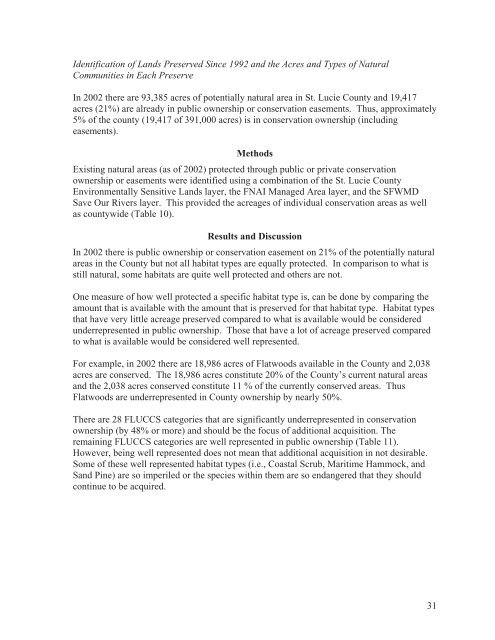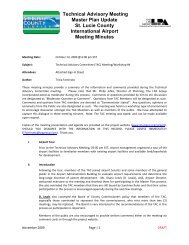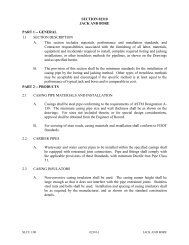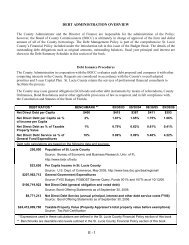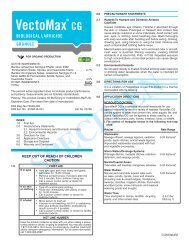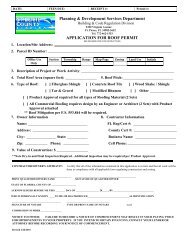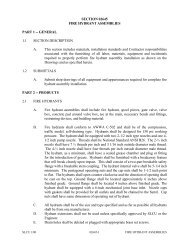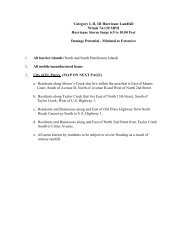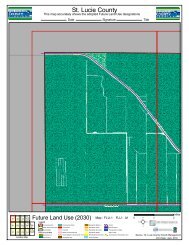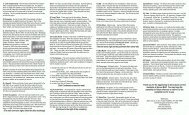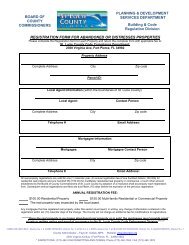Native Habitat Inventory Final Report 2004 - St. Lucie County
Native Habitat Inventory Final Report 2004 - St. Lucie County
Native Habitat Inventory Final Report 2004 - St. Lucie County
You also want an ePaper? Increase the reach of your titles
YUMPU automatically turns print PDFs into web optimized ePapers that Google loves.
Identification of Lands Preserved Since 1992 and the Acres and Types of Natural<br />
Communities in Each Preserve<br />
In 2002 there are 93,385 acres of potentially natural area in <strong>St</strong>. <strong>Lucie</strong> <strong>County</strong> and 19,417<br />
acres (21%) are already in public ownership or conservation easements. Thus, approximately<br />
5% of the county (19,417 of 391,000 acres) is in conservation ownership (including<br />
easements).<br />
Methods<br />
Existing natural areas (as of 2002) protected through public or private conservation<br />
ownership or easements were identified using a combination of the <strong>St</strong>. <strong>Lucie</strong> <strong>County</strong><br />
Environmentally Sensitive Lands layer, the FNAI Managed Area layer, and the SFWMD<br />
Save Our Rivers layer. This provided the acreages of individual conservation areas as well<br />
as countywide (Table 10).<br />
Results and Discussion<br />
In 2002 there is public ownership or conservation easement on 21% of the potentially natural<br />
areas in the <strong>County</strong> but not all habitat types are equally protected. In comparison to what is<br />
still natural, some habitats are quite well protected and others are not.<br />
One measure of how well protected a specific habitat type is, can be done by comparing the<br />
amount that is available with the amount that is preserved for that habitat type. <strong>Habitat</strong> types<br />
that have very little acreage preserved compared to what is available would be considered<br />
underrepresented in public ownership. Those that have a lot of acreage preserved compared<br />
to what is available would be considered well represented.<br />
For example, in 2002 there are 18,986 acres of Flatwoods available in the <strong>County</strong> and 2,038<br />
acres are conserved. The 18,986 acres constitute 20% of the <strong>County</strong>’s current natural areas<br />
and the 2,038 acres conserved constitute 11 % of the currently conserved areas. Thus<br />
Flatwoods are underrepresented in <strong>County</strong> ownership by nearly 50%.<br />
There are 28 FLUCCS categories that are significantly underrepresented in conservation<br />
ownership (by 48% or more) and should be the focus of additional acquisition. The<br />
remaining FLUCCS categories are well represented in public ownership (Table 11).<br />
However, being well represented does not mean that additional acquisition in not desirable.<br />
Some of these well represented habitat types (i.e., Coastal Scrub, Maritime Hammock, and<br />
Sand Pine) are so imperiled or the species within them are so endangered that they should<br />
continue to be acquired.<br />
31


